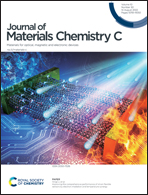Controlled growth of 3D assemblies of edge enriched multilayer MoS2 nanosheets for dually selective NH3 and NO2 gas sensors†
Abstract
Herein, we report on the successful controlled growth of edge enriched 3D assemblies of MoS2 nanosheets by adjusting the gas flow rate during atmospheric pressure CVD. The results revealed that 30 ml min−1 was the optimal flow rate, in which the growth direction shifts from in-plane nanosheets to out-of-plane 3D assemblies of MoS2 nanosheets. It is suggested that, at this flow rate, we have an ideal tradeoff between the surface interaction and the mass transport of precursor molecules. Morphological, structural and chemical composition analyses showed the formation of vertically oriented MoS2 nanosheets with MoO3−x impurities, resulting from the incomplete sulfurization during the synthesis. Based on the morphological evolution of the studied material, the growth mechanism was explored. The gas sensing properties of the as grown films were tested against NH3 and NO2. They exhibited stable and reproducible responses with excellent sensitivity to ppm-level NH3 (20% response to 2 ppm) and ppb-level NO2 (11% response to 20 ppb). Additionally, this nanomaterial showed dual selectivity towards NH3 at room temperature and NO2 at 100 °C. To the best of our knowledge, none of the reported studies on MoS2 based gas sensors have described this dual selectivity. The experimental detection limit was below 2 ppm for NH3 while it was below 20 ppb for NO2. Besides, the vertical growth of edge enriched MoS2 bestows the sensors with notable resilience against high levels of ambient humidity. The sensor response was only slightly increased (R = 70%) in a humid environment compared to a dry background (R = 65%) when measuring 800 ppb of NO2. Therefore, this paper shows for the first time that by adjusting the flow rate it is possible to tune the morphology of AP-CVD grown MoS2 for achieving a 3D sponge-like assembly of nanoflakes, showing high sensitivity to NO2 and NH3 and low humidity cross-sensitivity. In addition, the nanomaterial can be made quite specific for detecting NO2 or NH3 by selecting its operating temperature.



 Please wait while we load your content...
Please wait while we load your content...